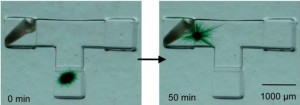The high peak intensity of femtosecond laser pulse can induce nonlinear absorption in transparent materials such as glass or clear polymers. The absorption occurring at the focal spot inside the transparent material allows the creation of 3D structures by material modification. The material modification fluence threshold is generally deterministic so that features smaller than the focused spot size can be produced.

Phormidium bacteria gliding in a nanoaquarium created with a femtosecond laser direct writing. DOI: 10.1039/C1LC20101H
Direct Writing
In certain optical materials, processing with femtosecond lasers causes a change of the refractive index at the laser focus. This change can be used to create optical waveguides and diffractive optic elements inside the bulk of a material. In the example on the right, IMRA’s femtosecond fiber laser was used to create a nano-aquarium for studying the movement of micro-organisms.
In-volume Selective Laser Etching
The area modified with a femtosecond laser has different chemical and mechanical properties than the bulk of the material. For some substances, the modified material is much more reactive with an etchant compared to the unmodified material. This process, called In-volume Selective Laser Etching (ISLE), was developed at IMRA’s Premier Applications Lab in Aachen, Germany and can be used to write features inside transparent materials.


